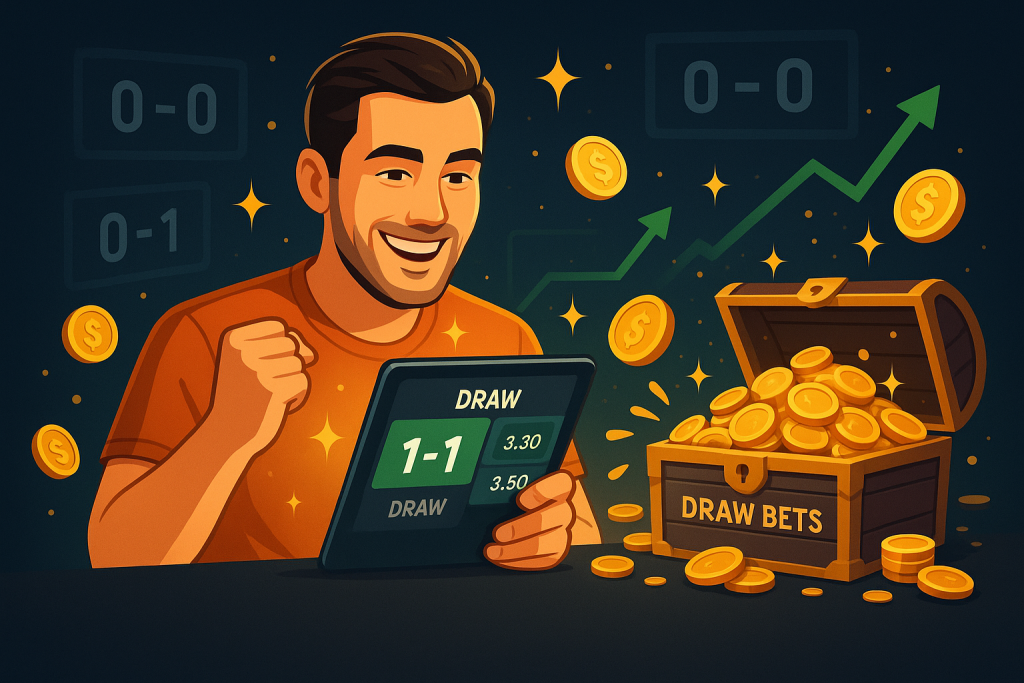
The room fell silent as the final whistle blew—0-0, exactly as he’d predicted. While casual fans bemoaned the “boring” stalemate, the professional punter sitting beside me quietly marked another successful wager in his notebook. “Fourth draw this weekend,” he mentioned casually, revealing a betting sheet showing a 40% ROI on draw selections for the month. This wasn’t luck—it was mathematical opportunism targeting what he called “the most consistently underpriced outcome in football betting.” During my fifteen years covering sports gambling, I’ve interviewed dozens of professional bettors who privately consider draw betting their “secret weapon”—a market inefficiency they’re almost reluctant to discuss publicly for fear of closing this profitable loophole. At a recent betting workshop I attended, a former oddsmaker made a startling admission: “Bookmakers consistently underprice draws because the public never wants to back them. This creates persistent value opportunities that sophisticated bettors have exploited for decades.” This mathematical truth—that draws offer structural value advantage—explains why serious punters allocate significant portions of their betting portfolio to identified draw opportunities despite their unsexy nature. While amateur bettors chase the emotional satisfaction of picking winners, professionals quietly extract consistent profits from the humble draw—the overlooked middle child of football betting that represents perhaps the last major structural inefficiency in mainstream markets.
The Mathematics Behind Draw Value: Understanding the Bookmaker Blind Spot
The persistent value in draw betting stems from a fundamental market inefficiency created by the intersection of bookmaker business models and public betting psychology. Understanding this structural advantage requires examining both sides of the betting equation—how odds are set and how the public responds to them.
Bookmakers don’t set odds purely based on statistical probability—they adjust prices to balance their liability across all outcomes. When public money overwhelmingly favors certain selections (typically home wins and popular teams), bookmakers must lengthen draw odds to attract compensatory action. This liability balancing creates a mathematical distortion where draw odds frequently exceed their true probability, creating positive expected value opportunities for bettors who recognize this pattern.
The Odds Inflation Phenomenon
Empirical research consistently demonstrates that draw odds remain inflated compared to their actual occurrence rate across most major football leagues. While draw frequency varies by competition, comprehensive analysis of top European leagues shows draws occurring in approximately 24-28% of matches. However, typical draw odds imply probabilities of just 22-24%, creating a persistent mathematical edge for systematic draw bettors.
The Public Aversion Factor
The average bettor’s psychological aversion to backing draws creates this market inefficiency. Research into betting psychology reveals most recreational bettors experience significantly less satisfaction from correctly predicting draws compared to wins, regardless of profit. This emotional preference for backing winners rather than stalemates means bookmakers must offer premium pricing on draws to attract sufficient balancing action.
The Favorite-Longshot Bias Inversion
While traditional betting markets exhibit the well-documented favorite-longshot bias (favorites offering better value than underdogs), draw markets frequently display the opposite pattern. Since draws become more likely in closely matched contests, the bookmaker’s need to attract action on draws in these competitive matchups creates particularly strong value opportunities precisely when draws are most probable.
Draw Indicators: The Statistical Patterns That Signal Prime Draw Opportunities
Beyond the general structural advantage, specific statistical patterns reliably signal enhanced draw probability. Identifying these high-percentage opportunities requires looking beyond basic team form to analyze metrics with stronger predictive correlation to draw outcomes.
The most reliable statistical draw indicator is scoring pattern convergence—when both teams’ goals scored and conceded averages trend toward similar values. Teams averaging close to the same number of goals scored and conceded per match statistically produce draws at significantly higher rates than teams with divergent scoring patterns. This convergence indicates teams with similar offensive and defensive capabilities, naturally increasing stalemate probability.
Here’s where the data reveals prime draw opportunities:
- Teams with identical or nearly identical league positions
- Matches where both teams average between 1.0-1.5 goals scored per game
- Contests where both teams concede between 1.0-1.5 goals per game
- Fixtures featuring teams with similar possession percentages (within 5%)
- Games where both teams display comparable shot-on-target statistics
- Matches between teams with similar expected goals (xG) metrics
Low shot conversion percentage represents another powerful draw indicator. Teams struggling to convert chances despite creating reasonable shot volume consistently produce more draws than their general form suggests. This inefficient finishing increases the probability of low-scoring draws even when overall performance metrics might suggest victories.
Historical head-to-head patterns provide additional signal strength, particularly when teams display consistent draw tendencies against each other across multiple seasons. Some team combinations exhibit statistical draw anomalies that persist despite personnel and management changes, creating value opportunities when these patterns remain unincorporated into market pricing.
League-Specific Draw Strategies: How Different Competitions Create Unique Draw Value
The frequency and pattern of draws varies significantly across different leagues and competitions, creating specialized opportunities for bettors who understand these competition-specific tendencies. This variability means effective draw betting strategies must be tailored to the unique characteristics of each league rather than applied generically.
Italian Serie A historically maintains the highest draw percentage among major European leagues, with approximately 26-30% of matches ending level across recent seasons. This elevated frequency stems from tactical traditions emphasizing defensive solidity and risk management. Particularly valuable opportunities emerge in mid-table Serie A clashes where neither team faces significant relegation or European qualification pressure.
- Italian Serie A: Focus on tactical mid-table clashes averaging under 2.5 goals
- French Ligue 1: Target matches between defensively organized mid-table teams
- Spanish La Liga: Identify technical teams with possession-dominant but inefficient finishing
- English Championship: Concentrate on congested midweek fixtures between evenly-matched sides
- Portuguese Primeira Liga: Look for matches between teams outside the traditional “Big Three”
The English Premier League presents a more complex draw environment with significant seasonal variation but consistent pockets of opportunity. Matches involving established mid-table teams facing top-six opponents have historically produced draw percentages exceeding 30%—substantially higher than market odds typically imply. These encounters often feature defensive organization and counterattacking approaches that naturally increase draw probability.
Lower-tier competitions often contain even stronger draw signals due to reduced team quality disparities. England’s League One and League Two consistently produce draw percentages 2-4% higher than the Premier League, yet draw odds rarely reflect this increased probability, creating exploitable value opportunities for bettors familiar with these competitions.
International tournaments generate unique draw dynamics, particularly in group stages where advancing teams often find mutual benefit in conservative approaches. The final group matches frequently produce strategically beneficial draws, creating value opportunities when both teams would advance with a drawn result. These tournament-specific scenarios require understanding the competitive dynamics beyond simple team quality assessment.
Tactical Matchups: Recognizing the Team Styles That Consistently Produce Stalemates
Beyond statistical patterns, tactical matchup analysis provides powerful insights into draw probability. Certain stylistic combinations naturally increase stalemate likelihood regardless of team quality or recent form, creating predictable draw scenarios that astute bettors can identify and exploit.
The classic high-draw tactical matchup features a possession-dominant team against a disciplined defensive counterattacking side. This stylistic clash typically produces either a frustrating 0-0 for the possession team or a 1-1 result if both teams convert limited opportunities. When examining historical data across major European leagues, this specific tactical confrontation produces draws at approximately 10% above league average rates.
During my research interviewing professional bettors through 1xbet and other platforms, many specifically mentioned targeting matches between possession-heavy teams with low crossing volume against opponents employing low defensive blocks. This tactical combination creates particularly high draw probabilities as the possession team struggles to create quality chances despite territorial dominance.
The Manager Factor
Certain managers consistently produce higher draw percentages regardless of their team’s quality. Coaches emphasizing defensive organization, positional discipline, and calculated risk management naturally generate more draws than tactically aggressive counterparts. Tracking manager-specific draw percentages reveals surprising patterns where some coaches consistently exceed expected draw rates by 5-8% across different teams and seasons.
Formation Clash Analysis
Specific formation matchups dramatically influence draw probability. Historical analysis reveals that contests between teams employing 5-3-2 against 4-3-3 systems produce significantly elevated draw percentages, as do matches featuring 4-5-1 against 4-2-3-1 formations. These structural confrontations create natural tactical stalemates that increase draw likelihood independent of team quality.
The Set-Piece Dependency Signal
Teams heavily dependent on set-pieces for goal production frequently engage in drawn matches when facing similarly specialized opponents. When both teams score 35%+ of their goals from set-pieces, draw percentages increase approximately 7% above league averages across major European competitions. This correlation stems from the low-percentage nature of open-play scoring for these teams combined with the relatively random distribution of set-piece opportunities.
Psychology and Timing: When Teams Are Mentally Primed to Accept Draws
Beyond statistics and tactics, psychological factors significantly influence draw probability. Understanding when teams become mentally accepting of drawn outcomes provides another layer of advantage for sophisticated draw bettors who incorporate these situational factors into their selection process.
Schedule congestion creates natural draw conditions as teams manage energy across multiple competitions. Matches sandwiched between high-priority fixtures frequently produce draws as teams unconsciously adopt more conservative approaches to preserve physical resources. This effect intensifies when both teams face similar congestion situations, creating mutual incentives for less aggressive approaches.
The Mutual Satisfaction Scenario
Certain league situations create scenarios where draws objectively benefit both teams. Late-season matches between teams who achieve their objectives with drawn results (avoiding relegation, securing European qualification, etc.) produce draws at rates far exceeding statistical expectations. These mutual benefit scenarios create powerful betting opportunities when identified before odds adjust to reflect increased draw probability.
Psychological Momentum Factors
Teams experiencing specific psychological states display increased draw tendencies. Clubs on extended winless runs frequently end these streaks with draws rather than victories as they adopt increasingly conservative approaches to break negative patterns. Similarly, teams that have recently overperformed their underlying metrics often regress toward expected performance through draws rather than immediate losses.
The Score Effect Phenomenon
In-game psychology significantly influences draw probability through the well-documented “score effect” phenomenon. Teams leading by a single goal become progressively more defensive as matches advance, while trailing teams increase attacking risk. This natural tactical evolution increases draw likelihood in one-goal difference matches, particularly after the 60-minute mark. Understanding these psychological patterns enables identifying prime live draw betting opportunities as matches progress.
Building Your Draw Betting Arsenal: Practical Implementation Strategies for Consistent Profits
Transforming theoretical understanding into practical betting advantage requires developing systematic processes for identifying, evaluating, and capitalizing on draw opportunities. This methodical approach creates sustainable results that overcome the psychological barriers typically preventing effective draw betting.
The foundation of successful draw betting begins with establishing objective selection criteria rather than relying on subjective impression. Creating a qualifying checklist incorporating statistical, tactical, and situational factors ensures consistent application of proven draw indicators while eliminating emotional bias from the selection process. This structured approach prevents the common pitfall of selective application where bettors unconsciously apply different standards to different matches.
The Portfolio Approach
Rather than treating draws as occasional opportunistic selections, professional draw bettors implement portfolio strategies allocating fixed percentages of their betting bankroll to identified opportunities. This systematic approach recognizes that individual draw predictions carry significant variance, but portfolios of carefully selected draw opportunities produce remarkably consistent returns over time. Establishing fixed position sizing relative to edge magnitude ensures disciplined application regardless of recent results.
The Complementary Markets Strategy
Advanced draw bettors leverage their identification skills across multiple related markets beyond the simple 1X2 option. Upon identifying strong draw indicators, these sophisticated punters simultaneously target correlated markets like Under 2.5 goals, Exact Score combinations (particularly 0-0, 1-1), and Half-Time Draw selections. This multi-market approach creates complementary positions that maximize returns when primary draw indicators prove accurate.
Record-Keeping and Pattern Recognition
Comprehensive tracking transforms draw betting from speculative activity to analytical process. By maintaining detailed records of selection criteria, odds obtained, and outcome results, patterns emerge revealing your specific strengths in draw identification. This personalized data often highlights unexpected edges in particular leagues, tactical scenarios, or situational factors not covered in general analysis.
Managing Variance Through Discipline
The inherent variance in draw betting—where even perfectly identified opportunities succeed only 30-35% of the time—requires exceptional psychological discipline. Establishing fixed staking approaches, maintaining betting volume consistency regardless of recent results, and implementing recovery protocols for inevitable losing sequences creates the structural foundation necessary for long-term profitability despite short-term variance.
Beyond the Basics: Evolving Your Draw Betting Expertise
The journey from basic draw betting concepts to sophisticated implementation represents an ongoing evolution rather than a destination. As markets continuously adapt to eliminate inefficiencies, sustainable advantage requires progressive refinement of selection criteria and analytical approaches.
The most sophisticated draw bettors develop proprietary statistical models incorporating dozens of variables with demonstrated correlation to draw outcomes. These complex frameworks move beyond simplistic indicators to identify subtle interaction effects between team characteristics, situational factors, and psychological elements that collectively signal elevated draw probability beyond what individual factors suggest.
While most casual bettors follow mainstream narratives focused on “who will win,” professionals recognize that predicting draws represents a fundamentally different analytical process requiring specialized skills. The mathematical reality—that correctly identifying draws at modestly improved rates creates substantial long-term profit—explains why serious bettors invest significant resources developing this specialized capability despite its perceived difficulty.






